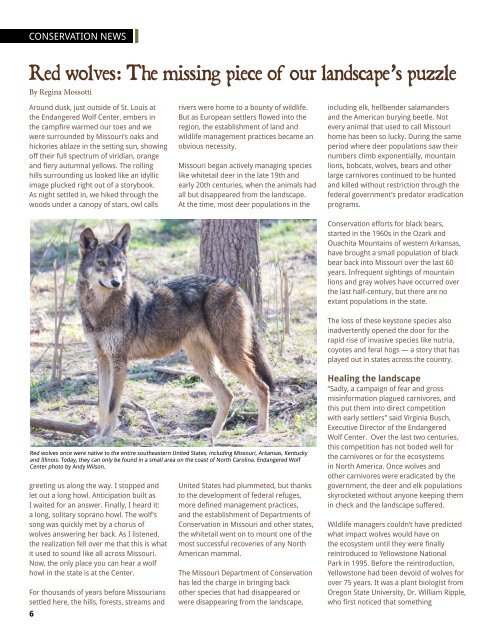Winter 2016
Winter2016Magazine
Winter2016Magazine
You also want an ePaper? Increase the reach of your titles
YUMPU automatically turns print PDFs into web optimized ePapers that Google loves.
CONSERVATION NEWS<br />
Red wolves: The missing piece of our landscape’s puzzle<br />
By Regina Mossotti<br />
Around dusk, just outside of St. Louis at<br />
the Endangered Wolf Center, embers in<br />
the campfire warmed our toes and we<br />
were surrounded by Missouri’s oaks and<br />
hickories ablaze in the setting sun, showing<br />
off their full spectrum of viridian, orange<br />
and fiery autumnal yellows. The rolling<br />
hills surrounding us looked like an idyllic<br />
image plucked right out of a storybook.<br />
As night settled in, we hiked through the<br />
woods under a canopy of stars, owl calls<br />
rivers were home to a bounty of wildlife.<br />
But as European settlers flowed into the<br />
region, the establishment of land and<br />
wildlife management practices became an<br />
obvious necessity.<br />
Missouri began actively managing species<br />
like whitetail deer in the late 19th and<br />
early 20th centuries, when the animals had<br />
all but disappeared from the landscape.<br />
At the time, most deer populations in the<br />
including elk, hellbender salamanders<br />
and the American burying beetle. Not<br />
every animal that used to call Missouri<br />
home has been so lucky. During the same<br />
period where deer populations saw their<br />
numbers climb exponentially, mountain<br />
lions, bobcats, wolves, bears and other<br />
large carnivores continued to be hunted<br />
and killed without restriction through the<br />
federal government’s predator eradication<br />
programs.<br />
Conservation efforts for black bears,<br />
started in the 1960s in the Ozark and<br />
Ouachita Mountains of western Arkansas,<br />
have brought a small population of black<br />
bear back into Missouri over the last 60<br />
years. Infrequent sightings of mountain<br />
lions and gray wolves have occurred over<br />
the last half-century, but there are no<br />
extant populations in the state.<br />
The loss of these keystone species also<br />
inadvertently opened the door for the<br />
rapid rise of invasive species like nutria,<br />
coyotes and feral hogs — a story that has<br />
played out in states across the country.<br />
Red wolves once were native to the entire southeastern United States, including Missouri, Arkansas, Kentucky<br />
and Illinois. Today, they can only be found in a small area on the coast of North Carolina.Endangered Wolf<br />
Center photo by Andy Wilson.<br />
greeting us along the way. I stopped and<br />
let out a long howl. Anticipation built as<br />
I waited for an answer. Finally, I heard it:<br />
a long, solitary soprano howl. The wolf’s<br />
song was quickly met by a chorus of<br />
wolves answering her back. As I listened,<br />
the realization fell over me that this is what<br />
it used to sound like all across Missouri.<br />
Now, the only place you can hear a wolf<br />
howl in the state is at the Center.<br />
For thousands of years before Missourians<br />
settled here, the hills, forests, streams and<br />
6<br />
United States had plummeted, but thanks<br />
to the development of federal refuges,<br />
more defined management practices,<br />
and the establishment of Departments of<br />
Conservation in Missouri and other states,<br />
the whitetail went on to mount one of the<br />
most successful recoveries of any North<br />
American mammal.<br />
The Missouri Department of Conservation<br />
has led the charge in bringing back<br />
other species that had disappeared or<br />
were disappearing from the landscape,<br />
Healing the landscape<br />
“Sadly, a campaign of fear and gross<br />
misinformation plagued carnivores, and<br />
this put them into direct competition<br />
with early settlers” said Virginia Busch,<br />
Executive Director of the Endangered<br />
Wolf Center. Over the last two centuries,<br />
this competition has not boded well for<br />
the carnivores or for the ecosystems<br />
in North America. Once wolves and<br />
other carnivores were eradicated by the<br />
government, the deer and elk populations<br />
skyrocketed without anyone keeping them<br />
in check and the landscape suffered.<br />
Wildlife managers couldn’t have predicted<br />
what impact wolves would have on<br />
the ecosystem until they were finally<br />
reintroduced to Yellowstone National<br />
Park in 1995. Before the reintroduction,<br />
Yellowstone had been devoid of wolves for<br />
over 75 years. It was a plant biologist from<br />
Oregon State University, Dr. William Ripple,<br />
who first noticed that something


